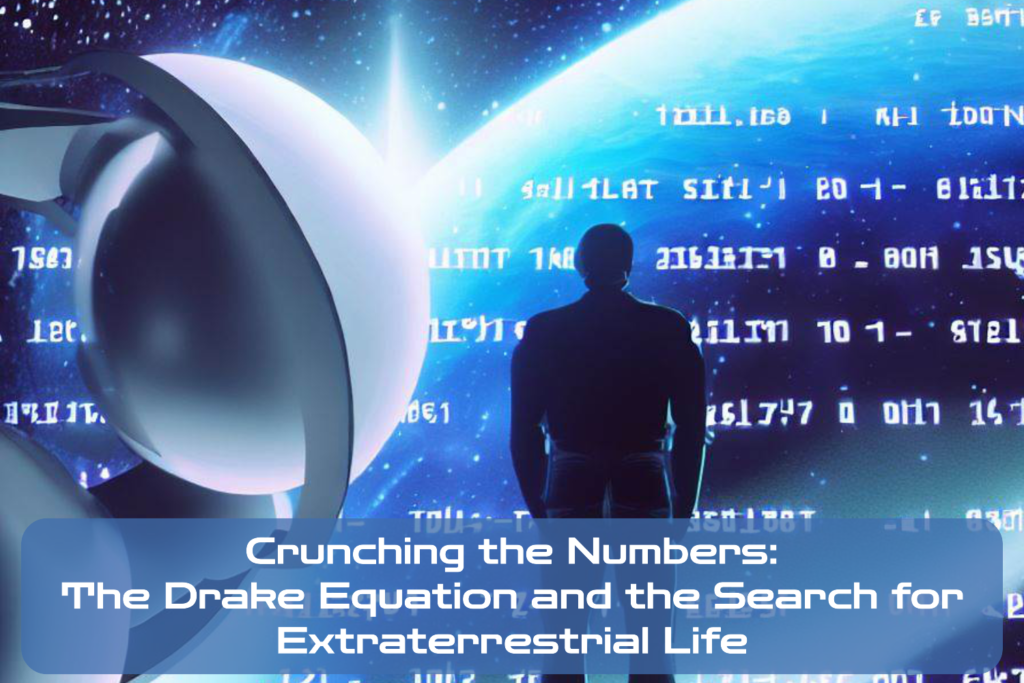The Perfect Equation for Finding Alien Life
Are we alone in the universe? This is one of the greatest questions that has puzzled humanity since the dawn of time. For years, scientists have pondered over this question, and many believe they are close to finding an answer.
The Drake equation is a mathematical formula that attempts to estimate the possibility of extraterrestrial life by taking various factors into account. It has been a topic of much debate and controversy, but its importance cannot be overstated in our search for life beyond Earth.
The Purpose of the Drake Equation

The idea behind the Drake equation is simple – it tries to quantify how many intelligent civilizations there might be in our galaxy.
The equation was first proposed by astronomer Frank Drake in 1961 during a meeting on detecting extraterrestrial intelligence held at the National Radio Astronomy Observatory (NRAO) in Green Bank, West Virginia. He developed this formula as a way of estimating how many alien civilizations capable of communicating with us might exist out there.
The equation uses seven variables to estimate how many advanced civilizations might be out there: R*, fp, ne, fl, fi, fc and L.
Each variable represents a different factor related to the formation and evolution of stars and planets.
For example, R* stands for “the average rate of star formation per year,” while L represents “the length of time such civilizations release detectable signals into space.”
By multiplying these seven variables together, you get an estimate for N – the number of advanced civilizations currently existing in our galaxy with which communication might be possible.
The Ongoing Debate About Extraterrestrial Life

The question of whether we are alone or not remains one of humanity’s biggest mysteries. Despite numerous efforts over countless years searching for signs or signals from other life forms beyond our planet using radio telescopes or SETI missions (Search for Extraterrestrial Intelligence), there has yet to be any concrete evidence of intelligent life.
But this lack of proof doesn’t necessarily mean that we’re completely alone in the universe. Many scientists believe that there is a high probability of extraterrestrial life in our galaxy based on studies of exoplanets and the potential habitable zones around stars.
The Drake equation offers an optimistic outlook that advanced civilizations could exist beyond our planet. However, some scientists criticize the equation for being overly simplistic and based on assumptions, rather than solid data.
Despite this debate, continuing research in astrobiology and space exploration will eventually lead us to more concrete answers about the existence of intelligent life beyond Earth. The Drake equation serves as a framework for understanding what factors need to be taken into account when estimating the chances of finding life elsewhere in the universe.
The Components of the Drake Equation

What is the Drake Equation?
The Drake equation is a mathematical formula developed by astronomer Frank Drake in 1961 to estimate the probability of finding extraterrestrial civilizations. It’s not an exact science, but it provides a framework for thinking about the factors that could contribute to life beyond Earth.
Breaking Down Each Variable
Let’s go over each variable in detail and see how they contribute to estimating the probability of extraterrestrial life.
R*
R* represents the average rate at which stars form in our galaxy. This variable affects the overall number of stars that are potential hosts for planets, that could possibly harbor life.
fp
fp represents the fraction of those stars that have planets around them. This variable takes into account how common planetary systems are around stars and how many planets are within habitable zones – areas where temperatures are suitable for liquid water to exist.
ne
ne represents the average number of habitable planets per star with planets. This variable considers factors such as planet size, composition, and distance from their star that would allow conditions for life similar to Earth.
fl
fl represents the fraction of habitable planets where life actually arises. This variable considers factors such as environmental conditions (e.g., temperature, water availability), chemical reactions leading to self-replication and complexity, and other prerequisites necessary for life’s emergence.
fi
fi represents the fraction of civilizations that develop intelligent life-forms capable of communication. This variable accounts for whether or not a civilization can progress beyond simple microbial organisms.
fc
fc represents the fraction of civilizations that develop communication technologies like radio transmitters or lasers – methods used for interstellar communication across vast distances.
L
L represents the length of time during which civilizations continue to emit these detectable signals. This variable considers how long extraterrestrial civilizations are active and communicating with us.
Contribution of Each Variable to Estimating Probability
Each variable in the Drake equation contributes differently to estimating the probability of extraterrestrial life. Some variables, such as R* and fp, have greater impacts on overall probability than other variables, like fl and L – which rely on more unknown factors. The uncertainties associated with each variable contribute to a wide range of possible outcomes for estimating this probability, indicating that we still have much more research to conduct in this field.
The Controversy Surrounding the Drake Equation

Criticisms of the Equation
The Drake equation has been criticized for a variety of reasons.
One of the most common criticisms is that it oversimplifies a complex and multifaceted problem. The equation relies on several assumptions, such as the assumption that life elsewhere in the universe will share similarities with life on Earth.
Some critics argue that this oversimplification leads to an inaccurate estimate of the probability of extraterrestrial life.
Another criticism is that some variables in the equation are not well-defined or have limited data available.
For example, we know very little about fi and fc, which refer to the fraction of planets with intelligent life and communication capabilities, respectively. Without sufficient data for these variables, it becomes difficult to accurately estimate their contribution to the overall probability.
Addressing Counterarguments
Despite these criticisms, defenders of the Drake equation argue that it remains a useful tool for stimulating scientific discussion and inquiry. The equation serves as a starting point for exploring questions about astrobiology and space exploration.
It also helps focus attention on areas where more research is needed. Proponents also point out that while some variables in the equation may be uncertain or unknown at present, continued advances in scientific knowledge could help fill in those gaps over time.
In addition, even if we acknowledge limitations in our current understanding of certain variables, we can still use the information we do have to explore what scenarios are plausible or possible.
Ultimately, while criticisms of the Drake equation should not be ignored or dismissed outright, they do not negate its usefulness as a thought-provoking tool for exploring important questions about our place in the universe.
Applications of the Drake equation

A guide for SETI research
The Drake equation has been an invaluable tool for scientists conducting searches for extraterrestrial intelligent life. It provides a rough estimate of how many civilizations may exist in our galaxy, and allows researchers to pinpoint areas of space where they may be more likely to find them.
For example, if the value of R*, which represents the rate of star formation in our galaxy, is estimated to be high, then scientists know that they should focus their search on younger stars that are more likely to harbor Earth-like planets.
SETI (Search for Extraterrestrial Intelligence) researchers have used the Drake equation as a guide when designing their methods for detecting signals from potential alien civilizations. By estimating values for each variable in the equation, they can determine what kind of signals would be detectable by their equipment and where it would be most effective to search.
A framework for astrobiology research
The Drake equation has also influenced our understanding of astrobiology as a field.
Astrobiology is the study of life in the universe and how it originated and evolved on Earth and other worlds. The Drake equation serves as a framework for thinking about how common or rare life may be in the universe, which guides astrobiologists in their search for evidence of extraterrestrial life.
By exploring each component of the equation, astrobiologists can speculate about what kinds of environments might be conducive to supporting life elsewhere in the universe. For example, by estimating values for ne (the number of habitable planets per star system), we can narrow down our search to those planetary systems most likely to harbor biological organisms.
Inspiring space exploration
The Drake Equation has inspired space exploration efforts by fueling curiosity about what lies beyond our own planet. By giving us an idea of just how vast and diverse our universe is, it has encouraged scientists to continue pushing boundaries and exploring new frontiers.
The search for extraterrestrial life is a major driving force behind many recent space missions. For example, NASA’s Kepler mission was designed to discover Earth-sized planets orbiting other stars, based on estimates of the frequency of such planets provided by the Drake equation.
And the James Webb Space Telescope is being used to study exoplanet atmospheres for signs of habitability and possibly even life.
The Drake Equation has been an essential tool for scientists studying astrobiology and conducting searches for extraterrestrial intelligence.
By providing a framework for estimating the likelihood of intelligent life elsewhere in our galaxy, it has guided researchers’ efforts and inspired space exploration endeavors. As we continue to learn more about our universe through these efforts, we may one day discover that we are not alone after all.
Implications for Humanity

The Search for Extraterrestrial Life
The search for extraterrestrial life has been a tantalizing possibility since humans first looked up at the stars. It has captured the imagination of scientists, authors, and filmmakers alike.
However, what would happen if we were to discover that life exists beyond Earth? The implications of such a discovery would be profound and far-reaching.
What It Would Mean for Us as a Species
The discovery of extraterrestrial life would be one of the most significant events in human history. It would confirm that we are not alone in the universe and could prompt an existential shift in the way we view ourselves as a species. The implications of such a discovery could have wide-ranging effects on everything from religion to politics to philosophy.
For example, discovering intelligent life beyond Earth could revolutionize our understanding of consciousness and self-awareness. If other beings possess similar cognitive abilities to humans, it could shed new light on questions about our place in the universe and what it means to be conscious.
Are We Ready?
While discovering extraterrestrial life may seem like an exciting prospect, there are many who question whether we are ready for such a revelation. The discovery could potentially challenge long-standing beliefs and shake up social norms.
Some worry that it could lead to societal upheaval or even panic. In addition to these concerns, there is also the issue of how we would interact with any discovered extraterrestrial life forms.
We currently have no framework or protocol for making contact with other intelligent beings from beyond our planet. This raises questions about how we should approach communication with them and what kind of impact our interactions might have on their culture or way of life.
While discovering extraterrestrial life may seem like something out of science fiction, it is becoming increasingly likely as our technology and knowledge of the universe continue to advance. As we continue our search for life beyond our planet, it is important to consider what such a discovery would mean for us as a species and whether we are truly ready for it.
Final Thoughts

What we’ve learned through the Drake equation
The Drake equation has been an essential tool for scientists to estimate the probability of extraterrestrial life. By considering various astronomical factors, we can understand how many planets in our galaxy might be able to support life. However, there are also many unknown variables that make this calculation difficult, and as a result, there is still much debate about whether we are alone in the universe.
Despite these limitations, the equation has pushed us to explore new frontiers in astrobiology and space exploration. Scientists have used it as a starting point for developing new technologies and conducting research that may one day lead us to discover extraterrestrial life.
The importance of continued research
As we continue our search for answers about our place in the galaxy, it’s crucial that we keep exploring new avenues of research. We need to invest more resources in studying exoplanets and developing more advanced telescopes capable of detecting signs of life on distant planets.
In addition to technological advancements, continued scientific curiosity is essential for driving progress in understanding astrobiology. We need a collective effort from scientists across multiple disciplines working together towards a common goal – uncovering the secrets of our universe.
While there is still much work left to be done before we can say with certainty whether or not extraterrestrial life exists, it’s clear that humanity is making significant strides towards understanding our place in the cosmos. The Drake equation has been a vital tool for advancing astrobiology and space exploration as fields, pushing us to ask new questions and seek out answers beyond our own planet.
As technology improves and humanity continues its quest for knowledge about the universe around us, it seems increasingly likely that one day soon we will finally discover evidence of extraterrestrial life. And when that day comes, it will be a momentous occasion, marking a significant milestone in our scientific understanding and opening up new possibilities for the future of humanity.

C M, a seasoned editor, journalist, and consultant, is deeply fascinated by the convergence of technology, space, and the future of humanity.
With a particular interest in transhumanity, futurology, and the philosophical and ethical dimensions of these domains, C M serves as the lead contributor to SpaceSpotlight and TranscendSphere.
When not penning insightful articles on these rapidly evolving fields, C M indulges in their love for podcasts and books, proudly embracing their status as a ‘Happy Nerd Extraordinaire!’



